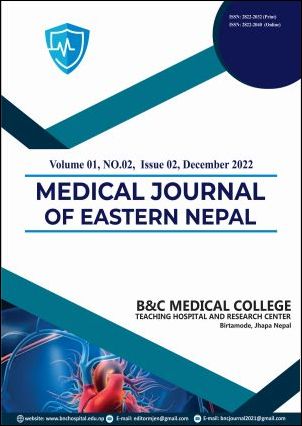Comparative Study on Laparoscopic Hernia Repair: Totally Extra Peritoneal Repair (TEP) and Transabdominal Preperitoneal (TAPP) at a Tertiary Care Centre
DOI:
https://doi.org/10.3126/mjen.v1i02.51157Keywords:
Inguinal hernia, Laparoscopic hernia repair, Transabdominal preperitoneal (TAPP), Totally extra peritoneal (TEP)Abstract
Background Minimal invasive surgery (MIS) procedures in the early 90's as laparoscopic transabdominal preperitoneal repair (TAPP) and totally extra peritoneal repair (TEP), have gained popularity worldwide over open hernia mesh repair with low recurrences, complications and early return to work and activities. This retrospective study aims to compare the two laparoscopic procedures regarding various parameters like duration of surgery, postoperative complications and duration of hospital stay in various ages and different sexes as described in the methodology.
Methods This is a retrospective study for over 2 years which included patients with unilateral inguinal hernia both direct and indirect using either (TAAP) or (TEP) technique.
Results Among sixty patients with an inguinal hernia, 30 patients had undergone (TAPP) and 30 had undergone (TEP). The duration of surgery for (TAPP) was observed 111.03±13.71 minutes which was significantly higher than that of (TEP) (92.80±8.24 minutes) at P<0.001. The pain score at 6 hours for (TEP) was 6.97±1.01 in comparison to 8±0.00 for (TAPP) (P<0.001). The pain score at 24 hours for (TAPP) was 5.18±1.00 in contrast to 4.27±0.70 for (TEP) (P<0.001).
Conclusion Both (TAPP) and (TEP) are feasible surgical options to treat an inguinal hernia. (TAPP) had significantly longer operating time and more early post-operative pain as compared to (TEP). However, there was no significant difference in hospital stay, post-operative complications in both the group.
Downloads
Downloads
Published
How to Cite
Issue
Section
License
Copyright (c) 2022 B & C Medical College and Teaching Hospital and Research Centre

This work is licensed under a Creative Commons Attribution 4.0 International License.
CC BY: This license allows reusers to distribute, remix, adapt, and build upon the material in any medium or format, so long as attribution is given to the creator. The license allows for commercial use.




